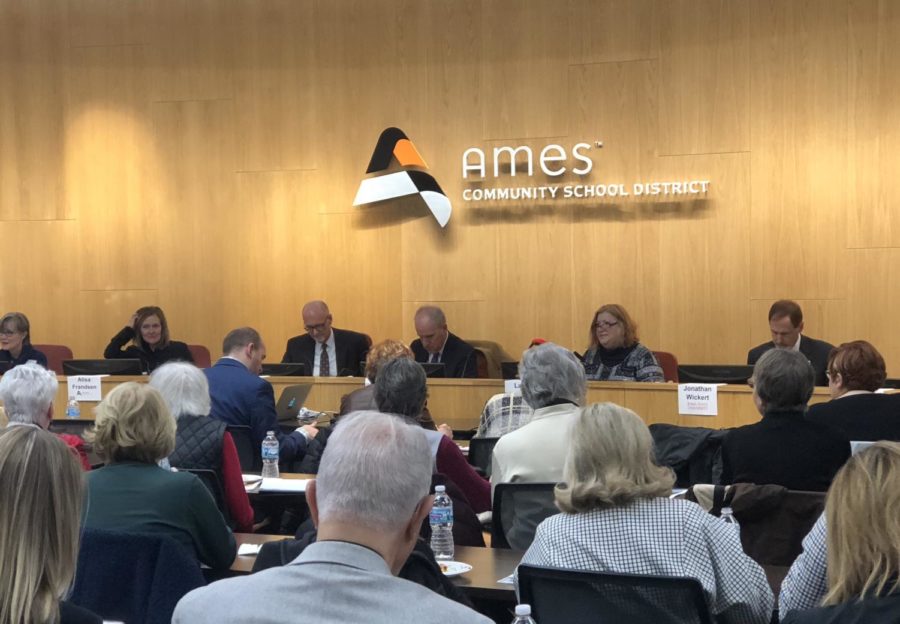Ames leaders lay out challenges for the new year
January 18, 2019
Community leaders focused on diversity and growth in Ames, talked about the challenges their institutions face and fielded questions about the partial Federal Government shutdown Friday at the Ames School District Board Room.
Iowa State Senior Vice President and Provost Jonathan Wickert joined Mayor John Haila, Mary Greeley Medical Center President Brian Dieter, Story County Board of Supervisors Chair Lauris Olson, Ames School Board of Directors President Alisa Frandsen and DMACC President Rob Denson for a panel discussion on the state of the community.
Representatives spoke about how their organizations are being affected by the partial federal government shutdown and what they are doing to combat those effects.
“For students, there is a slow down in applying for [FAFSA loans],” Wickert said. “And graduate students who are supported on federal assistantships [are affected]. We’re gonna do our best to take care of those students and make sure they are helped.”
Furloughed federal employees will have difficulty paying medical bills, so Dieter detailed initiatives at Mary Greeley Medical Center to help those employees and others who are ill afford their payments.
“The hospital can offer financially assisted care, which could mean as much as a 100 percent write off of healthcare costs,” Dieter said. “We also offer catastrophic medical assistance, where, if someone’s bills exceed 25 percent of their annual income, we never expect them to pay more than that. Our emergency department always stands ready to serve anyone regardless of ability to pay.”
He also said that the hospital provides millions of dollars worth of discounted or free medical care every year.
Representatives also discussed how their institutions were striving to create more inclusive environments.
“Having a welcome campus environment is one of the points of the university’s strategic plan,” Wickert said. “We’ve struck up four work groups on campus: One directed at the workplace needs of faculty, one for staff, one for graduate students and postdocs and the fourth group is for undergraduate students. We’re now developing specific actions in response to our campus climate survey.”
Haila is responsible for appointing people to boards and commissions and plans to use that responsibility to increase minority representation, starting with the Human Relations Commission.
“My goal is to add Hispanic, Chinese, African American and LGBTQ+ representation to get that cross section because they’re working on very important things,” Haila said. “Then the next step is to spread that across all boards and commissions to try and clarity across our community.”
Representatives talked about the goals and achievements of their institutions, as well as the challenges they seek to overcome moving forward.
“This year I’m proud to say we have our most diverse incoming freshman class the school has ever had,” Wickert said. “The enrollment of multicultural students is up 9 percent from last year. One out of four students on our campus is either multi-cultural or an international student.”
Wickert detailed Iowa State’s performance among students relative to other regent universities.
“If we look at things like student persistence, which is how many freshmen are coming back for a sophomore year, we’re 13 percent better than the national average,” Wickert said. “We outperform the average college by 20 percentage points when it comes to graduation rates.”
Wickert then explained how, among those graduates, there is an employment rate of 95 percent within the first three years after graduating.
“Those aren’t people working at Starbucks or McDonalds, which are honorable trades,” Wickert said. “These graduates are being hired in the same fields they researched while they were students here.”
He also talked about the growth of Iowa State’s Research Park.
“We added 12 new companies to the Research Park… which employs 2,100 people plus 450 Iowa State students,” Wickert said. “We bring in over $245 million each year in externally funded research. These are dollars that come from companies and the Federal Government to fund salaries and programs at the university.”
The University isn’t the only school showing expansion into 2019. Enrollment at Ames Community Schools is increasing, and Frandsen updated the community to the status of the new Ames High School.
“We’re currently in the design and development phase with our architects and construction managers working,” Frandsen said. “They will bring [their final plans] to the board for approval at the end of February.”
Frandsen said the new school will help the board focus on its goal of providing as many students as possible with an adequate learning space.
“It’s such an exciting time for us to see all of these conversations we’ve had over the years to come to fruition and to see what this school is going to look like,” Frandsen said.
Haila said the city faced challenges with communication, increasing its workforce, providing the best possible housing and inclusivity.
“These aren’t the only challenges in Ames,” Haila said. “These are just some of the ones that pop out.”
Haila also discussed upcoming developments in the city, including construction on Welch Avenue, the Healthy Life Center and Sunsmart Ames.
“The Healthy Life Center is one unique opportunity for our community to help intergenerationally meet the needs for healthy lifestyles,” Haila said. He also discussed how the city is increasing its efforts to communicate with the citizenry.
“We can’t knock on everybody’s door whenever there’s a new development and ask them what they think about it,” he said.
Haila talked about how staff had been reaching out to different business, institutional and neighborhood leaders to gather input on different projects and urged people to give their input on the upcoming Comprehensive Plan.
“Feb. 5 will be our first public forum,” Haila said. “Please make it a priority to come to that. We want to hear from everyone in the community and get their input.”







